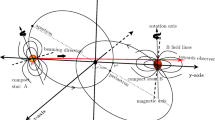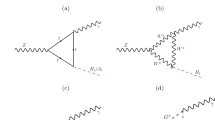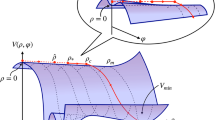Abstract
The Standard Model Higgs potential seems unstable at field values h > htop ~ 1010 GeV. Vacuum decay can be triggered by N ~ 4π/λ ~ 1000 overlapped Higgs bosons with energy \( \sqrt{\lambda } \)htop. However, this configuration is stimulated by ultra-high energy collisions with a exp(−\( \mathcal{O} \)(N)) suppression, comparable to spontaneous vacuum decay: no ‘Higgspolosion’ enhancement arises. This implies that ultra-high energy cosmic ray collisions are safe, despite that their number (in production sites) likely is tens of orders of magnitude higher than what usually estimated (in space). We speculate on how vacuum decay could be induced classically, forming a in-coming wave of N boosted Higgs bosons at futuristic ultra-high energy colliders, and on how the resulting vacuum bubble could be controlled to extract energy.
Article PDF
Similar content being viewed by others
Avoid common mistakes on your manuscript.
References
D. Buttazzo et al., Investigating the near-criticality of the Higgs boson, JHEP 12 (2013) 089 [arXiv:1307.3536] [INSPIRE].
J.R. Espinosa et al., The cosmological Higgstory of the vacuum instability, JHEP 09 (2015) 174 [arXiv:1505.04825] [INSPIRE].
R. Franceschini et al., The collider landscape: which collider for establishing the SM instability?, JHEP 08 (2022) 229 [Erratum ibid. 03 (2023) 167] [arXiv:2203.17197] [INSPIRE].
S.R. Coleman, The Fate of the False Vacuum: Semiclassical Theory, Phys. Rev. D 15 (1977) 2929 [Erratum ibid. 16 (1977) 1248] [INSPIRE].
G. Isidori, G. Ridolfi and A. Strumia, On the metastability of the standard model vacuum, Nucl. Phys. B 609 (2001) 387 [hep-ph/0104016] [INSPIRE].
G. Isidori, V.S. Rychkov, A. Strumia and N. Tetradis, Gravitational corrections to standard model vacuum decay, Phys. Rev. D 77 (2008) 025034 [arXiv:0712.0242] [INSPIRE].
A. Andreassen, W. Frost and M.D. Schwartz, Scale Invariant Instantons and the Complete Lifetime of the Standard Model, Phys. Rev. D 97 (2018) 056006 [arXiv:1707.08124] [INSPIRE].
P.B. Arnold and S. Vokos, Instability of hot electroweak theory: bounds on mH and Mt, Phys. Rev. D 44 (1991) 3620 [INSPIRE].
A. Shkerin and S. Sibiryakov, Black hole induced false vacuum decay: the role of greybody factors, JHEP 08 (2022) 161 [arXiv:2111.08017] [INSPIRE].
A. Strumia, Black holes don’t source fast Higgs vacuum decay, JHEP 03 (2023) 039 [arXiv:2209.05504] [INSPIRE].
I.K. Affleck and F. De Luccia, Induced vacuum decay, Phys. Rev. D 20 (1979) 3168 [INSPIRE].
K.B. Selivanov and M.B. Voloshin, Destruction of false vacuum by massive particles, JETP Lett. 42 (1985) 422 [INSPIRE].
V.G. Kiselev, The False vacuum decay induced by a two particle collision in two-dimensions, Phys. Rev. D 45 (1992) 2929 [INSPIRE].
J.R. Ellis, A.D. Linde and M. Sher, Vacuum stability, wormholes, cosmic rays and the cosmological bounds on mt and mH, Phys. Lett. B 252 (1990) 203 [INSPIRE].
M.B. Voloshin, Catalyzed decay of false vacuum in four-dimensions, Phys. Rev. D 49 (1994) 2014 [hep-ph/9309237] [INSPIRE].
K. Enqvist and J. McDonald, Can cosmic ray catalysed vacuum decay dominate over tunneling?, Nucl. Phys. B 513 (1998) 661 [hep-ph/9704431] [INSPIRE].
D. Levkov and S. Sibiryakov, Real-time instantons and suppression of collision-induced tunneling, JETP Lett. 81 (2005) 53 [hep-th/0412253] [INSPIRE].
A. Gorsky and M.B. Voloshin, Particle decay in false vacuum, Phys. Rev. D 73 (2006) 025015 [hep-th/0511095] [INSPIRE].
A. Monin and M.B. Voloshin, Semiclassical calculation of an induced decay of false vacuum, arXiv:1004.2015 [INSPIRE].
S. Demidov and D. Levkov, High-energy limit of collision-induced false vacuum decay, JHEP 06 (2015) 123 [arXiv:1503.06339] [INSPIRE].
B. Grinstein and C.W. Murphy, Semiclassical Approach to Heterogeneous Vacuum Decay, JHEP 12 (2015) 063 [arXiv:1509.05405] [INSPIRE].
M. Hellmund and J. Kripfganz, The Decay of the sphalerons, Nucl. Phys. B 373 (1992) 749 [INSPIRE].
See e.g. L. Landau and E.M. Lifshitz, Quantum Mechanics, sections 51 (‘Calculation of the quasi-classical matrix elements’) and 52 (‘The transition probability in the quasi-classic case’) in the English edition published by Pergamon (1977).
A.S. Gorsky and M.B. Voloshin, Nonperturbative production of multiboson states and quantum bubbles, Phys. Rev. D 48 (1993) 3843 [hep-ph/9305219] [INSPIRE].
Y.B. Zeldovich, I.Y. Kobzarev and L.B. Okun, Cosmological Consequences of the Spontaneous Breakdown of Discrete Symmetry, Zh. Eksp. Teor. Fiz. 67 (1974) 3 [INSPIRE].
A.N. Kuznetsov and P.G. Tinyakov, False vacuum decay induced by particle collisions, Phys. Rev. D 56 (1997) 1156 [hep-ph/9703256] [INSPIRE].
J.M. Cornwall, On the High-energy Behavior of Weakly Coupled Gauge Theories, Phys. Lett. B 243 (1990) 271 [INSPIRE].
H. Goldberg, Breakdown of perturbation theory at tree level in theories with scalars, Phys. Lett. B 246 (1990) 445 [INSPIRE].
M.B. Voloshin, Multiparticle amplitudes at zero energy and momentum in scalar theory, Nucl. Phys. B 383 (1992) 233 [INSPIRE].
M.V. Libanov, V.A. Rubakov, D.T. Son, S.V. Troitsky, Exponentiation of multiparticle amplitudes in scalar theories, Phys. Rev. D D50 (1994) 7553 hep-ph/9407381.
V.V. Khoze, Perturbative growth of high-multiplicity W, Z and Higgs production processes at high energies, JHEP 03 (2015) 038 [arXiv:1411.2925] [INSPIRE].
V.V. Khoze, Diagrammatic computation of multi-Higgs processes at very high energies: Scaling log σn with MadGraph, Phys. Rev. D 92 (2015) 014021 [arXiv:1504.05023] [INSPIRE].
C. Degrande, V.V. Khoze and O. Mattelaer, Multi-Higgs production in gluon fusion at 100 TeV, Phys. Rev. D 94 (2016) 085031 [arXiv:1605.06372] [INSPIRE].
M. Dine, H.H. Patel and J.F. Ulbricht, Behavior of Cross Sections for Large Numbers of Particles, arXiv:2002.12449 [INSPIRE].
G. Badel, G. Cuomo, A. Monin and R. Rattazzi, The Epsilon Expansion Meets Semiclassics, JHEP 11 (2019) 110 [arXiv:1909.01269] [INSPIRE].
S.V. Demidov, B.R. Farkhtdinov and D.G. Levkov, Suppression exponent for multiparticle production in λϕ4 theory, JHEP 02 (2023) 205 [arXiv:2212.03268] [INSPIRE].
V.A. Rubakov and P.G. Tinyakov, Towards the semiclassical calculability of high-energy instanton cross-sections, Phys. Lett. B 279 (1992) 165 [INSPIRE].
V.A. Rubakov, D.T. Son and P.G. Tinyakov, Classical boundary value problem for instanton transitions at high-energies, Phys. Lett. B 287 (1992) 342 [INSPIRE].
D.T. Son, Semiclassical approach for multiparticle production in scalar theories, Nucl. Phys. B 477 (1996) 378 [hep-ph/9505338] [INSPIRE].
S. Dimopoulos and G.L. Landsberg, Black holes at the LHC, Phys. Rev. Lett. 87 (2001) 161602 [hep-ph/0106295] [INSPIRE].
S.B. Giddings and S.D. Thomas, High-energy colliders as black hole factories: The End of short distance physics, Phys. Rev. D 65 (2002) 056010 [hep-ph/0106219] [INSPIRE].
G. Dvali, G.F. Giudice, C. Gomez and A. Kehagias, UV-Completion by Classicalization, JHEP 08 (2011) 108 [arXiv:1010.1415] [INSPIRE].
L.A. Anchordoqui, Ultra-High-Energy Cosmic Rays, Phys. Rept. 801 (2019) 1 [arXiv:1807.09645] [INSPIRE].
R. Alves Batista et al., Open Questions in Cosmic-Ray Research at Ultrahigh Energies, Front. Astron. Space Sci. 6 (2019) 23 [arXiv:1903.06714] [INSPIRE].
R. Aloisio, Ultra High Energy Cosmic Rays an overview, J. Phys. Conf. Ser. 2429 (2023) 012008 [arXiv:2212.01600] [INSPIRE].
Pierre Auger collaboration, An Indication of anisotropy in arrival directions of ultra-high-energy cosmic rays through comparison to the flux pattern of extragalactic gamma-ray sources, Astrophys. J. Lett. 853 (2018) L29 [arXiv:1801.06160] [INSPIRE].
Telescope Array collaboration, Search for Large-scale Anisotropy on Arrival Directions of Ultra-high-energy Cosmic Rays Observed with the Telescope Array Experiment, Astrophys. J. Lett. 898 (2020) L28 [arXiv:2007.00023] [INSPIRE].
P. Hut and M.J. Rees, How stable is our vacuum?, Nature 302 (1983) 508 [INSPIRE].
W. Busza, R.L. Jaffe, J. Sandweiss and F. Wilczek, Review of speculative ‘disaster scenarios’ at RHIC, Rev. Mod. Phys. 72 (2000) 1125 [hep-ph/9910333] [INSPIRE].
F.E. Taylor, Comparison of cosmic ray flux at \( \sqrt{s} \) > 14 TeV with LHC luminosity, arXiv:0805.4528 [INSPIRE].
J.R. Ellis et al., Review of the Safety of LHC Collisions, J. Phys. G 35 (2008) 115004 [arXiv:0806.3414] [INSPIRE].
Y.I. Salamin, M. Wen and C.H. Keitel, A cosmic Zevatron based on cyclotron auto-resonance, Astrophys. J. 907 (2021) 24 [arXiv:2007.06409] [INSPIRE].
Z. Osmanov, S. Mahajan, G. Machabeli and N. Chkheidze, Extremely efficient Zevatron in rotating AGN magnetospheres, Mon. Not. Roy. Astron. Soc. 445 (2014) 4155 [arXiv:1404.3176] [INSPIRE].
K. Schawinski, M. Koss, S. Berney and L. Sartori, Active galactic nuclei flicker: an observational estimate of the duration of black hole growth phases of ~ 105 yr, Mon. Not. Roy. Astron. Soc. 451 (2015) 2517 [arXiv:1505.06733] [INSPIRE].
D. Barducci and A. Strumia, A boosted muon collider, arXiv:2306.12480 [INSPIRE].
A. Papaefstathiou, S. Plätzer and K. Sakurai, On the phenomenology of sphaleron-induced processes at the LHC and beyond, JHEP 12 (2019) 017 [arXiv:1910.04761] [INSPIRE].
W.E. East et al., Spacetime Dynamics of a Higgs Vacuum Instability During Inflation, Phys. Rev. D 95 (2017) 023526 [arXiv:1607.00381] [INSPIRE].
A. Strumia and N. Tetradis, Higgstory repeats itself, JHEP 09 (2022) 203 [arXiv:2207.00299] [INSPIRE].
C.D. Froggatt and H.B. Nielsen, Standard model criticality prediction: Top mass 173 ± 5 GeV and Higgs mass 135 ± 9 GeV, Phys. Lett. B 368 (1996) 96 [hep-ph/9511371] [INSPIRE].
S.R. Coleman and F. De Luccia, Gravitational Effects on and of Vacuum Decay, Phys. Rev. D 21 (1980) 3305 [INSPIRE].
F.J. Dyson, Search for Artificial Stellar Sources of Infrared Radiation, Science 131 (1960) 3414.
T.Y.-Y. Hsiao et al., A Dyson sphere around a black hole, Mon. Not. Roy. Astron. Soc. 506 (2021) 1723 [arXiv:2106.15181] [INSPIRE].
Acknowledgments
This work was supported by the MIUR grant PRIN 2017L5W2PT.
Author information
Authors and Affiliations
Corresponding author
Additional information
Publisher’s Note
Springer Nature remains neutral with regard to jurisdictional claims in published maps and institutional affiliations.
ArXiv ePrint: 2301.03620
Rights and permissions
Open Access . This article is distributed under the terms of the Creative Commons Attribution License (CC-BY 4.0), which permits any use, distribution and reproduction in any medium, provided the original author(s) and source are credited.
About this article
Cite this article
Strumia, A. Triggering Higgs vacuum decay. J. High Energ. Phys. 2023, 62 (2023). https://doi.org/10.1007/JHEP09(2023)062
Received:
Revised:
Accepted:
Published:
DOI: https://doi.org/10.1007/JHEP09(2023)062




